
|
|

March 28, 2008
WFUV 90.7, New York
In this week's installment of Tower Site of the Week, we continue to dig through our archives to catch up on some of the many fascinating studio and transmitter sites in the biggest radio market in America.
That would be New York, of course, and this week we offer one of the two New York stations to build completely new studios and transmission facilities within the last few years. One such station is WOR, whose studios and transmitters we've profiled here on several occasions. But the other is on the noncommercial end of the FM dial - Fordham University's WFUV (90.7), one of the few New York stations to call the Bronx home.
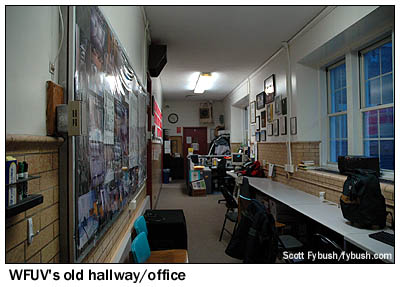 |
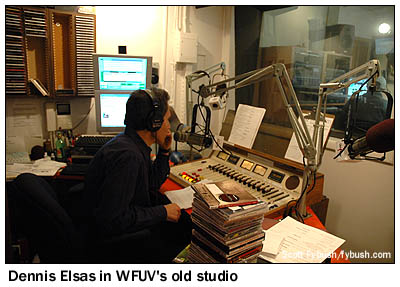 |
For 60 years, WFUV has served greater New York from the campus of Fordham University in the Bronx, and for most of that time, it did so from the same studios where the station began way back in 1948, upstairs in Keating Hall on the Fordham campus.
When we first visited in 2005, the station had long since outgrown those digs, spread out along two hallways surrounding the central courtyard of the building. From humble origins as a student-run station, WFUV had become a major public radio voice for New York, making a name for itself as the city's home for AAA music, as well as Fordham sports, local news, a long-running lineup of weekend specialty shows, and a DJ lineup that included famous Big Apple names such as Pete Fornatale, Vin Scelsa and Dennis Elsas.
WFUV's facilities were struggling to keep pace. The main air studio was tiny, distinguished mainly by some very, very orange Formica on the countertops. Live performances were squeezed into another small studio. The sports department was tucked in behind that; the newsroom shared another small room with the station's engineering racks; CDs were stored in drawers in a hallway - you get the picture.
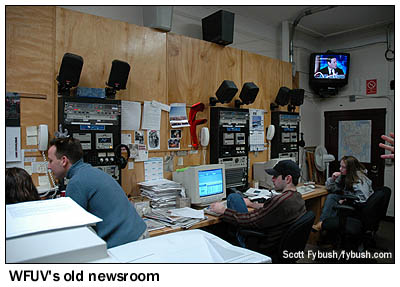
|
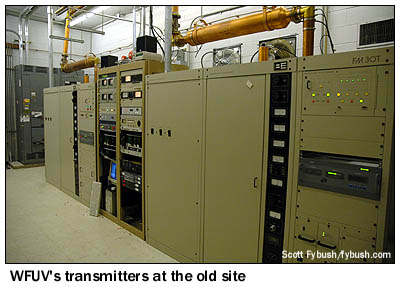
|
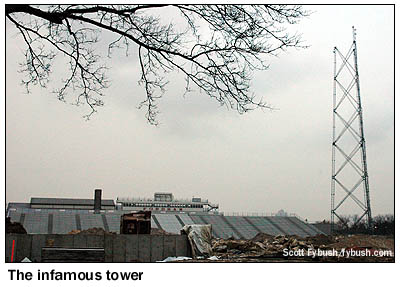 But
even before WFUV could deal with its desperate need for new studio
and office space, it had another problem to contend with - it
needed someplace to hang its antenna.
But
even before WFUV could deal with its desperate need for new studio
and office space, it had another problem to contend with - it
needed someplace to hang its antenna.
After decades transmitting from atop Keating Hall, WFUV was forced to relocate in the early nineties because of RF radiation issues there.
In 1994, WFUV began construction on what was to have been a 480-foot self-supporting tower on the edge of campus. But that tower quickly hit a snag - it was right across the street from the New York Botanical Garden, which began to loudly protest the tower as an eyesore, filing lawsuit upon lawsuit in an attempt to halt completion of the tower.
As a result, the tower remained unfinished - about 260' tall - for more than a decade, with WFUV operating at reduced height from a two-bay antenna attached to one uncompleted leg of the tower.
In the meantime, by the time of our visit in early 2005, WFUV was moving forward on a major studio move, relocating from the top of Keating Hall to the basement and doubling its floor space from 3,000 square feet to 6,000.
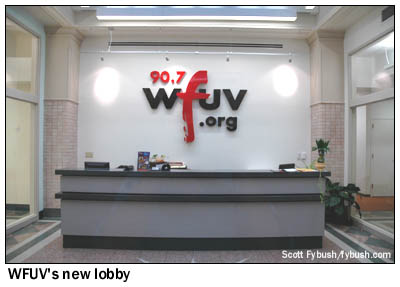
|
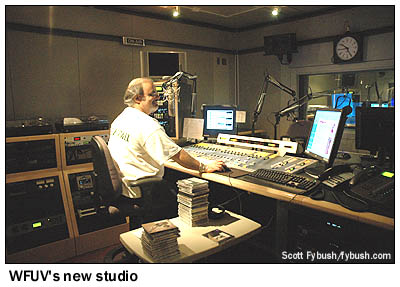
|
By the time we visited again in 2006, the move was complete - and what a change it was! Instead of a desk in a hallway, the station now had a proper lobby, lit by a skylight looking up to the courtyard above. The lobby looks in on a big conference room that can be used for phone banks during pledge drives - and instead of being in a separate building across campus, the membership and development staff are now right there, too.
And instead of a couple of cramped studios, the new WFUV boasts no fewer than eight studios - four main control rooms (essential to allow for pre-recording certain specialty shows and for separate programming on the multicast services the station is now launching), a talk studio, two voice-over booths, and a spacious studio specifically designed for live performances.
WFUV Director of Technical Operations George Evans tried something different with these studios - they're prefabricated "V-Room" studios from Wenger Corp., assembled on-site and providing remarkable levels of acoustic isolation. (That's important - just outside the studio hallway sits a student lounge, where video monitors now offer glimpses of the performances taking place inside.)
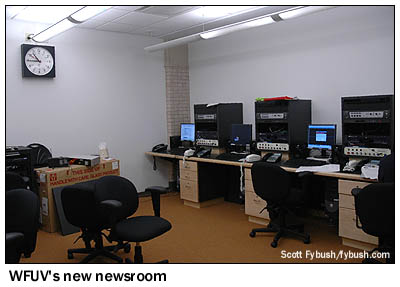
|
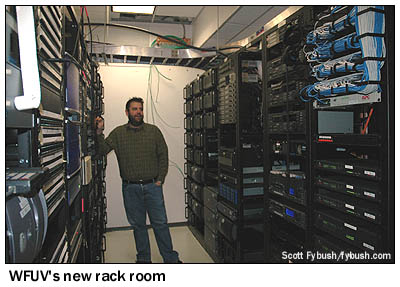
|
There's a proper newsroom and sports area now, too, as well as office space for the DJs. A station-wide SAS router system makes incoming audio available at most of these desks, and they're each equipped with Pro Tools as well, allowing a lot of editing to be done without even requiring a studio. (The consoles in the on-air studios are SAS Rubicon.)
And George even gets a proper rack room for all his equipment - all in all, a huge improvement over the antiquated facilities upstairs!
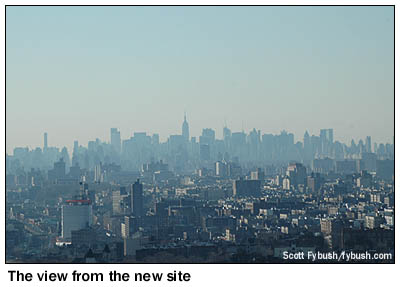
|
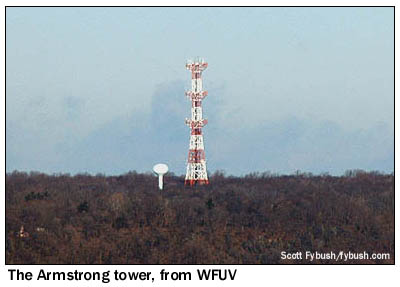
|
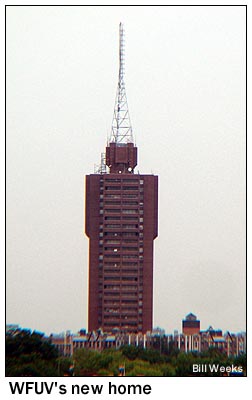 Meanwhile,
WFUV was finally moving ahead on that sticky tower issue. In
2004, Fordham worked out an arrangement with the nearby Montefiore
Medical Center to build a new tower atop an apartment building
owned by the medical school, off Gun Hill Road about a mile north
of the campus.
Meanwhile,
WFUV was finally moving ahead on that sticky tower issue. In
2004, Fordham worked out an arrangement with the nearby Montefiore
Medical Center to build a new tower atop an apartment building
owned by the medical school, off Gun Hill Road about a mile north
of the campus.
In September 2005, just as WFUV was moving into the new studios downstairs at Keating, a new 142-foot tower went into place atop the Montefiore building - and in May 2006, the never-completed tower on the campus quietly came down, ending the battle with the Botanical Garden after more than a decade.
Somehow, it took another couple of years before we finally connected with George for a tour of the new transmitter site - and what a nifty site it is!
This spot, at Wayne Ave. and Gun Hill Road, is one of the highest points in the city to begin with, and the new tower is supported by an apartment building that's 28 stories tall, with another 40 feet or so of mechanical penthouse above that.
The view from up on the roof is pretty spectacular - there's clean line of sight to most of Manhattan to the south (though WFUV augments its Manhattan coverage with a very directional on-channel booster aimed south from the Riverside Church near Columbia University), a nice view up Long Island Sound to the east, and to the west a pretty look across the Hudson at the New Jersey Palisades and at the historic Armstrong Tower that rises majestically from the cliffs, a little north of the George Washington Bridge.
Because of concerns about RF getting into the medical campus below, WFUV ended up with a 10-bay directional antenna for its analog and digital signals, with another two bays mounted below those for auxiliary analog/HD use.
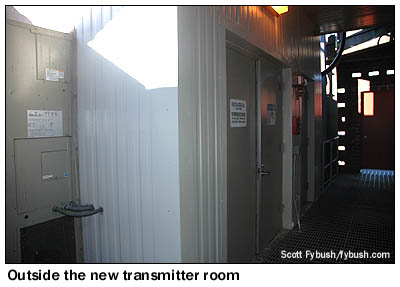
|
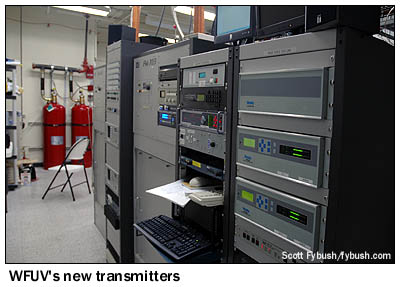
|
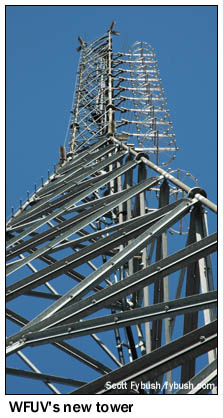
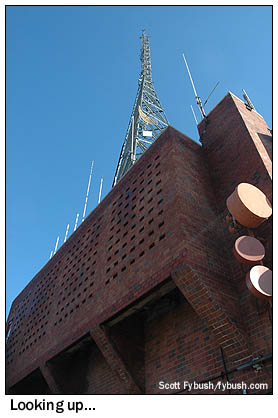 For a site that
wasn't designed for broadcast use initially, this building sure
adapted well.
For a site that
wasn't designed for broadcast use initially, this building sure
adapted well.
From the lower rooftop, a steep metal staircase ascends past the lower part of the mechanical penthouse, which houses the building's HVAC and electrical, up to the upper brick enclosure that was once home to the building's AC condensers.
The condensers were moved to a separate enclosure down below, and now the stairway opens into a space under the tower that's home to a prefab metal transmitter building and WFUV's generator.
Inside the prefab building, WFUV's two new BE transmitters hum along in both digital and analog, giving the station the best signal it's ever had.
Soon, WFUV may even have company up here - Cumulus has applied to move WFAS-FM (103.9 Bronxville) from its present home in Westchester County (also to be featured soon on Site of the Week) to the Montefiore rooftop, so we may have reason to come back up here for another look at more antennas on this cool-looking tower someday.
Tower Site Calendar 2008 is here! Visit the Fybush.com Store now and get your calendar now!
- Previous Site of the Week: WQEW, New York
- Next Week: WWDJ/WWRV, Hackensack, NJ
- Site of the Week INDEX!
- How can you help support Site of the Week? Click here!
- Submit your suggestions for a future Site of the Week!
